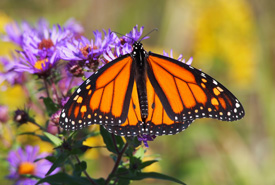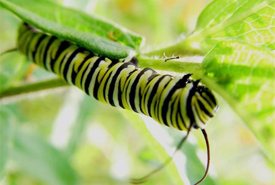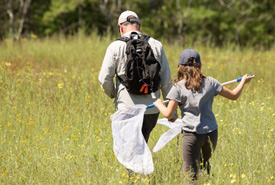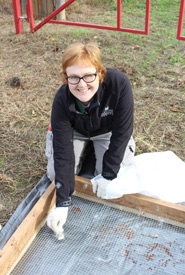Reigniting a love of insects

Monarch (Photo by NCC)
The love of insects can be a tough sell to many adults. Much like a fascination with dinosaurs, it seems that an interest in insects peaks during childhood and then declines for most people.
Butterflies, however, are one of the few insects that attract admirers of all ages. It makes sense; their colourful wings and fluttering flight makes them easy to notice, they feed on beautiful flowers and they don’t bite or sting. Even among this popular order of insects, one butterfly reigns supreme in the minds of most North Americans: the monarch.
The monarch butterfly checks all the right boxes for popular appeal: it’s beautiful, with its bright orange wings with bold black and white markings, it’s large (for a North American butterfly), it's widespread and it has a truly fascinating life cycle.
Just like the caterpillar in Eric Carle’s book The Very Hungry Caterpillar, monarchs undergo complete metamorphosis. They go from tiny egg on a leaf, to a growing caterpillar (eating milkweed leaves in real life, instead of dill pickles and chocolate cake like in the book), to a pupa (protected by a chrysalis), to a beautiful butterfly.

Monarch caterpillar (Photo by Rick Beaver)
If metamorphosis wasn’t fascinating enough, the Ontario monarch population also undertakes an incredible journey, migrating across the continent in the fall and spring. The first monarchs that we see in Ontario each spring have travelled from the southern United States. Upon their return to Ontario, they mate and seek out milkweed plants to lay their eggs on, dying soon after. The next few summer generations of monarchs complete their entire life cycles in Ontario. The adult butterflies live only six to eight weeks, expending their energy on reproduction.
Monarch butterflies that hatch in late August are the travellers. Instead of reproducing, this generation journeys thousands of kilometres south to the forests of Mexico to escape the cold Canadian winter. Unlike their parents, the butterflies that survive the journey will live for six to eight months and will not reproduce until spring, after they’ve begun their journey north again.
Sadly, monarch populations are at risk. They are listed as a species of special concern in Ontario, and as endangered in Canada. A major threat is habitat loss in their overwintering grounds in Mexico, due to forests being converted to agricultural land and illegal logging. Habitat loss is a threat in their breeding range too, as the use of pesticides on agricultural land reduces the availability of milkweed and native wildflowers. The protection and creation of native pollinator habitat throughout their continent-wide range is critical to their survival.
While I am an unabashed enthusiast of all insects, monarchs do hold a special place in my heart. During my undergraduate degree at the University of Guelph, I worked at a nearby butterfly conservatory, where I got to share the amazing story of the monarch with hundreds of children on class trips and at birthday parties.
After spending my summer as research assistant working at Point Pelee, a highlight for me was touring my grandfather around the park in the fall, looking for clusters of monarchs resting up on the trees for their journey across Lake Erie. He was always a backyard naturalist, and I was so proud to share what I was learning with him.

Conservation Volunteers at a butterfly count (Photo by NCC)
In my time with the Nature Conservancy of Canada (NCC), monarchs appeared in many of my most memorable days in the field. While working on St. Joseph Island, near Sault Ste. Marie, NCC conservation biologist Cara Copeland and I stumbled upon a blooming meadow that was bustling with pairs of monarchs mating in flight. I have had the pleasure of helping host many butterfly counts in the Carden Alvar over the years. These events are always well attended by expert and novice butterfly observers alike, and the data collected is used to monitor changes to butterfly populations over time.

Liv Monck-Whipp cleaning seeds at Norfolk milkweed seed collection Conservation Volunteers event (Photo by Christine Roberts)
Just this fall, I joined NCC conservation biologist Liv Monck-Whipp in Norfolk to host a Conservation Volunteers event to collect milkweed seeds that will be used to plant new pollinator habitat where a farm field used to be in the Backus Block.
I have also been working to create habitat for native pollinators in my own yard. My garden contains common, swamp and butterfly milkweed to host monarch larvae. I also try to have a diversity of native plants flowering throughout the season to provide nectar sources (this is still a work in progress!).
This summer, a monarch was often fluttering and feeding on our Joe-pyeweed. My two year-old son, ever the taxonomist, labeled these visitors as “orange flyaways.” I hope that they’ll be a fixture in his outdoor life, as they have been for me, and that they open the door to his curiosity into the diverse and wonderful world of insects.
To help restore pollinator habitat or contribute to long-term butterfly monitoring projects, check out NCC’s conservationvolunteers.ca website for upcoming volunteer events across the country. Spring and summer events for 2019 will be posted by April.


